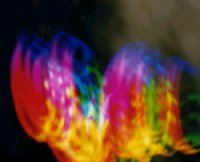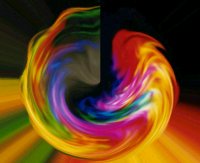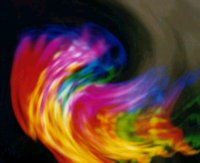
Synesthesia: The Crossing of the Senses
by Cheryl Lynne Bradley (c) 2001-10
"We interpret one sense by another."
William Hazlitt
"Although medicine has known about synaesthesia for three centuries, it keeps forgetting that it knows.
Richard Cytowic, in "Synaesthesia: Phenomenology and Neuropsychology
a Review of Current Knowledge"



Could you imagine going through life every day seeing sound, hearing colour, tasting shapes, hearing smells or tasting colours. These are some of the ways a synesthete experiences the world. One synesthete describes the experience of listening to a saxaphone as a writhing mass of neon-purple snakes hovering in the air another describes a mint as a cool, smooth glass tube.
"A red rings louder in your eye and a taste of blue lingers at your fingertips. You have a neighbor whose consistently green voice grates against his consistently deep blue suit. Nobody seems to understand. There are things you hear, things that you touch - that you cannot talk about. You don't believe yourself to be mad, or if you are, you no longer believe in what the word implies. You don't believe you're hallucinating...hallucinations should make less sense. This...this is an abundance of sense. " - Omar Kamel
Scientists have known about synesthesia for centuries. There is now a resurgence of interest in synesthesia and multi-disciplinary research into this unique condition, which colours certain individuals perceptions of the ordinary world, is now being conducted. The word synesthesia comes from the Greek words syn meaning together, and aisthesis meaning perception. It literally means a joining of sensations. Researchers view it as a window into thought itself.
Although there is some dispute, the first reference to synesthesia was probably in John Locke's "Essay Concerning Human Understanding". Locke shares with us the story of a blind man who felt "betrayed" when he learned what the colour scarlet meant. When his friend asked what he had thought scarlet was, the man answered "like the sound of a trumpet." It is also credited to Aristotle and Pythagoras. Pythagoras considered synesthesia to be the union of the illusory, constant, daily, repetitive, mundane world with the real, genuine world of universal and abstract concepts and ideas and, as such, was the greatest philosophical gift and spiritual achievement.
Synesthesia is clinically defined as an involuntary physical experience of a cross-modal association. This means an involuntary crossing of two or more senses. If you stimulate one sense it causes a stimulation in another sense as well. There are 31 possible combinations of the senses but usually there are only two senses which cross, and this brings the number of potential combinations down to 20. The pairings are generally one way, sound may create colour but colour will not create sound.
Synesthesia is divided into two categories, Two Sensory and Multiple Sensory. The most common type is the crossing of two sensory modalities, such as Coloured-Hearing or Chromaesthesia (seeing sound, hearing colour, experiencing colour linked to words, letters and numbers). Sound creating the perception of a colour is the most common form of synesthesia. Synesthetes of this type experience both written and spoken words in a wonderfully vivid experience of colour associations. They can see music, smell colors or taste words.
Coloured-Olfaction occurs when a smell creates the perception of a colour. Coloured-Gustation is a taste which stimulates a specific colour. Tactile-Gustation is the taste of something experienced as a shape. Multiple Sensory Synesthesia is the crossing of 3 or more senses.
Synesthesia may be idiopathic (developmental): the person has always experienced synesthesia; or non-idiopathic: the result of a known event or condition which was acquired and created the synesthesia.
Ideopathic Synesthesia occurs in an uninhibited natural state, has strong genetic factors and is felt to be a natural state of development particularly within the first 4 months of life. There are three theories which try to explain Coloured-hearing; unity of the senses or linkage theory, crosstalk theory or the theory which suggests it occurs at the higher cognitive/cortical level of the brain. Brain imaging tests show that words activate the synesthetes brains language, vision and colour processing centres. Non-Ideopathic Synesthesia can be caused by seizures, drugs, neuron degeneration, brain damage, spinal cord damage and concussions. The only symptom shared with a schizophrenic would be the ability to see things others do not. The synesthetes experiences are not like a hallucination and it has not been considered a mental illness or disorder for a long time.
The synesthetic experience is a left brain response and has been associated with a decreased blood supply to the neocortex. Researchers have found an increased blood flow in the parts of the brain that handle colour perception when synesthetes are listening to words. Control subjects did not show the same pattern. This supports synesthesia as genuinely taking place in the brain. It may be that synesthetes have extra dense neural connections between areas dealing with hearing and vision. Some ongoing research is focusing studies away from Coloured-hearing in the direction of Coloured-smell and are working with children to see how synesthesia may affect learning to read.
The estimates of the number of people who are synesthetes vary greatly, from one in 2,000 to one in every 25,000 people. Studies have indicated that women are more likely to be synesthetic - again the ratio varies from 3:1 in the United States to 8:1 in the United Kingdom. It occurs most frequently in left-handed and ambidextrous individuals. It is a unique brain experience which gets frequently linked to artistic genius. It is considered a source of inspiration for creative brilliance but sources disagree that it is more common in creative people or artists.
Most synesthetes function at a very high level, are highly intelligent and typically have excellent memories. Trouble telling left from right and a poor sense of direction are also common with synesthetes. Difficulties with math are not unusual, although noted Physicist Richard Feynman is synesthetic. It is also quite common for synesthetes to report frequent experiences of deja vu, clairvoyance, premonitions, the feeling of a presence and precognitive dreams. Fifteen percent of people with synesthesia have someone in their immediate family with autism, dyslexia or attention deficit disorder. The experience is different for every individual. Those people who see letters as coloured will see different colours than another person with the same condition. Most initially self-reference and assume that everyone experiences the world as they do.
These sensations are involuntary and cannot be held back or brought on, although their level and intensity may vary. The sensation is not in the persons imagination but is projected into their environment. One woman describes it as somewhat like a television screen about 6 inches in front of her face. The sensations are durable and generic. If red means "a" to you, it will always mean "a". The sensations are memorable - if you met someone and their name evoked the taste of chocolate, it is easier to remember the taste than the name, but the taste will help to recall the name. The sensations are emotional and viewed with a sense of ecstasy, achievement and satisfaction.
Take a minute right now and try this little experiment which will give you an idea of what synesthesia is like. Sit comfortably and press the heels of your hands firmly into your eyelids for a couple of minutes (don't hurt yourself). You will begin to see patterns, bursts of light and colours . While you are doing this move your pupils around and the patterns and colours will move also. Do this in silence or listen to music.
In his 1966 autobiography "Speak, Memory" Vladimir Nabokov, the Russian-born novelist, tells stories of arguing with his mother about the proper colours of letters in the alphabet. His mother was a synesthete as well - it often runs in families. "The long 'a' of the English alphabet . . . has for me the tint of weathered wood, but a French 'a' evokes polished ebony. . . . . there is steely 'x', thundercloud 'z' and huckleberry 'h'. ...Since a subtle interaction exists between sound and shape, I see 'q' as browner than 'k', while 's' is not the light blue of 'c', but a curious mixture of azure and mother-of-pearl.".
Olivier Messiaen is a French avant-garde composer who attributed his success to synesthesia.
"Whenever I hear music, or even if I read music, I see colors . . ." Alexander Scriabin was a Russian composer and pianist. He was one of the first synesthetes to thoroughly catalogue his colour-note associations. C# was violet and E was "pearly white and shimmer of moonlight."
Wassily Kandinsky, the Russian born abstract artist, embraced synesthesia. Some historians maintain he was an invented synesthete who used it for self-promotion as synesthetism was in vogue among the European avant garde. "The violins, the deep tones of the basses, and especially the wind instruments at that time embodied for me all the power of that pre-nocturnal hour. I saw all my colors in my mind; they stood before my eyes. Wild, almost crazy lines were sketched in front of me."
David Hockney is a British painter who designed sets for the New York Metropolitan Opera. "When it came time to paint the tree for Ravel, I put on the tree music from the opera, and it had a certain weight and colour. The music would dictate the shape."
The paintings of Georgia O'Keeffe are felt by some to reflect her synesthetic experience. She loved music and it often inspired her work - she could see the music in her mind. She was an artist who painted what she saw and loved vibrant colour, graceful curves and fluid movement which could very much speak to her being a synesthete or able to tap into that experience. Ms. O'Keefe was very structured in her approach to her painting and her colour palette. She was known to carefully chart all of her colours before beginning a painting and her studio was very structured. She often said she couldn't paint until her closets and drawers were in order.
Synesthesia is very specific condition but pseudosynesthesia also occurs frequently. Pseudosynesthesia can occur without intention, triggered by drug use or learned associations, or as an act of creation expressed through literature, music, and art. Hashish and opium are the most mentioned substances. A great many writers who used them wrote on and under the influence. Frequent references were made to hearing and smelling colors, seeing sounds, and even seeing feelings while they were high. The Caterpillar and the hookah (a hashish water pipe with four long stems to accommodate four smokers at once) in "Alice in Wonderland" by Lewis Carroll is a perfect example.
Mescaline, peyote, LSD and magic mushrooms can produce pseudosynesthetic experiences. Peyote is sacred to many Native tribes and is used in spiritual ceremonies. They generally produce the coloured-hearing variety. Another possible cause of pseudosynesthesia is thought to be learned association. This is quite controversial as it has also been offered as an explanation of actual cases of synesthesia. The theory suggests that the repetition of pairing the sensations creates the automatic association of those two sensations, i.e. repetition becomes habit.
The Spanish mystic and Kaballist, Abraham Abulafia (1240-1291?), used a meditation on the Name of God called Hokmah ha-Tseruf, The Science of the Combination of the Letters. The letters of the Divine Name were to be studied in different combinations to break the mind free of mundane understanding and enhance abstract perceptions. He compared the resulting experience to the sensation of listening to music with the letters of the alphabet becoming musical notes. It was meant to break the seals of the soul and, in so doing, one would discover the psychic resources of the mind and ease emotional suffering.
Synesthetes are "wired" a little differently than a "normal" person - although the only normal people I know are people I don't know very well yet. It certainly sounds like an enriched experience. My vivid imagination seems pale now when I try to picture what images and sounds a concert, an art exhibit or a child's laugh might evoke for a synesthete. Psychologists, neurologists and neuro-scientists are all hopeful that studying this unusual and extraordinary gift may shed some light on the amazing capabilities of the human brain and the mysteries of our consciousness.
"There are no limits to the mind unless we acknowledge them."
"The most beautiful thing we can experience is the mysterious. It is the source of all true art and all science. He to whom this emotion is a stranger, who can no longer pause to wonder and stand rapt in awe, is as good as dead: his eyes are closed."
Albert Einstein
Sources
Richard Cytowic, MD
Richard Cytowic, in "Synaesthesia: Phenomenology and Neuropsychology
a Review of Current Knowledge"
Maclester University
Sam Scott, Carleton University
A History of God
The 4,000 Year Quest of
Judaism, Christianity and Islam
by Karen Armstrong 1993
Ballantine Books
ISBN 0-345-38456-3
"Ah, the Blue Smell of It"
by Unmesh Kher
TIME Magazine, May 28, 2001, page 42
Canadian Edition
Do you see what they see? by Brad Lemley
Discover, December 1999
Omar Kamel
Synaesthesia
Bibliographia Studiorum Psychelicorum
An Entheogen Chrestomathy
Butterflies & Zebras Slide Show. Norm is a synesthete
What is Synaesthesia?"
Georgia O'Keeffe - biography and images



This page was created June 4, 2001 and updated 2010-05-04.






